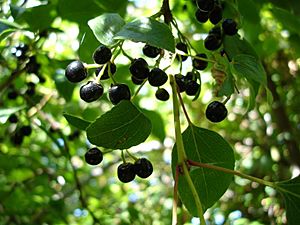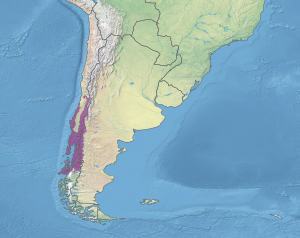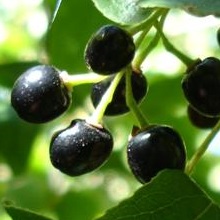Aristotelia chilensis facts for kids
Quick facts for kids Aristotelia chilensis |
|
|---|---|
 |
|
| Maqui tree with fruits | |
| Scientific classification | |
| Genus: |
Aristotelia (plant)
|
| Species: |
chilensis
|
 |
|
| The native area of the rainforest | |
| Synonyms | |
|
|
Aristotelia chilensis, known as Maqui, Maquiberry or Chilean wineberry, is a tree species in the Elaeocarpaceae family native to South America in the Valdivian temperate rainforests of Chile and adjacent regions of southern Argentina. Limited numbers of these trees are cultivated in gardens for their small fruits, known as maqui berries. Most of the fruits commercially marketed come from the wild.
Contents
Description
Tree
Aristotelia chilensis is a small dioecious evergreen tree that can reach 4 to 5 metres (13 to 16 ft) in height. Its divided trunk has a smooth bark. Its branches are abundant, thin and flexible. Its leaves are simple, opposite, hanging, oval-lanceolate, naked and coriaceous, with serrated edges. The leaf venation is highly visible, and the leaf stalk is a strong red color.
In the beginning of spring, the tree sheds the old leaf cohort, which is used as a carbohydrate source to form the new leaves and flowers.
Flowers and berries
When A. chilensis flowers at the end of spring, the white flowers are unisexual and small, eventually yielding a small edible fruit. The small purple-black berries that form are approximately 4 to 6 millimetres (0.16 to 0.24 in) in diameter and contain 4 to 8 angled seeds. A seven-year-old tree can produce up to 10 kilograms (22 lb) of berries per year. With fruit that tastes similar to blackberries, the species is known as the Chilean wineberry, and locally in Spanish as maqui or maque.
Distribution
Aristotelia chilensis is native to Chile and Argentina near the southwest coast of South America. It is found naturally in Chilean rainforests. Its native range spans the area between the Coquimbo and Aysén regions of Chile, and is 170,000 hectares (420,000 acres) in total.
Ecology
Maqui berries are a favored food for birds at the end of summer. Deforestation of the Valdivian temperate rainforests in Chile suppresses seed dispersal by birds and leads to inbreeding depression.
Harvesting and cultivation
The berries of A. chilensis are collected from wild plants from December to March of each year by families, mainly Mapuche, who collect their harvest near the Andes Mountains. The harvesting process involves collecting the side branches of trees, shaking them to separate the berries and leaves from the branches, and then employing a mechanical process to separate the berries from the leaves.
The stored fruits are sold in local markets, with prices ranging from $6.5 to $15 per kilogram ($2.9 to $6.8/lb). The average area yield is about 220 kilograms (490 lb) per hectare annually, with an estimated yearly total of only 90 short tons (180,000 lb), due to remote access and difficulty of transportation.
Aristotelia chilensis is planted in home gardens and is not grown on an orchard scale. Most of the fruits on the market have been gathered from the wild. Maqui is frost sensitive and fairly tolerant of seaside conditions. It prefers a well-drained soil in full sun, with some protection against cold, drying winds. The soil should be slightly acidic, with moderate fertility.
Aristotelia chilensis can be planted in USDA zones 8 to 12. It is cultivated in Spain, and in milder, moister areas of Britain, where winter freezes cause dieback, thereby stimulating growth of more shoots in spring.
Propagation
Seeds of A. chilensis germinate without cold stratification. In zones with the possibility of frost, it is recommended to sow in spring in a greenhouse. If they have grown enough, by autumn, the new plants can be planted into individual pots . The potted plants should stay in the greenhouse for the first winter.
The following year, after the last expected frost in spring, the plants can be planted out into their final positions. In their first winter outdoors, some type of frost protection is required. For further propagation, vegetative propagation is possible: cuttings of wood with a length of 15 to 30 centimetres (5.9 to 11.8 in) can be planted into pots. These cuttings normally root, and can be planted out in the following spring.
Anthocyanin content and Antioxidant capacity
Polyphenol research has been completed on the maqui berry, which showed its anthocyanin content to include eight glucoside pigments of delphinidin and cyanidin, with the principal anthocyanin being delphinidin 3-sambubioside-5-glucoside (34% of total anthocyanins). The average total anthocyanin content was 138 milligrams (2.13 gr) per 100 grams (3.5 oz) of fresh fruit, or 212 milligrams (3.27 gr) per 100 grams (3.5 oz) of dry fruit, ranking maqui berries low among darkly pigmented fruits for anthocyanin content (see table at anthocyanins). One study found that anthocyanins are also present in maqui leaves.
The nutritional value of A chilensis has been extensively studied after the first publication showing that this berry has higher phenol content and scores better for total radical trapping potential and total antioxidant reactivity in antioxidant capacity tests, when compared to berries such as strawberry, blackberry and blueberry. A chilenesis inhibits the oxidation of LDL cholesterol in-vitro and protects cultured human endothelial cells from oxidative stress caused by "bad cholesterol".
See also
 In Spanish: Maqui para niños
In Spanish: Maqui para niños


